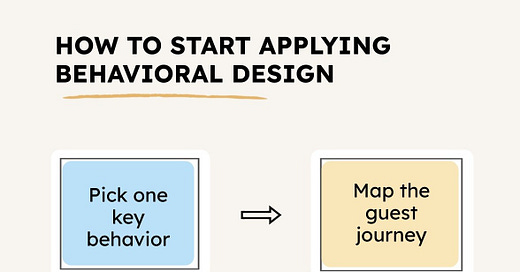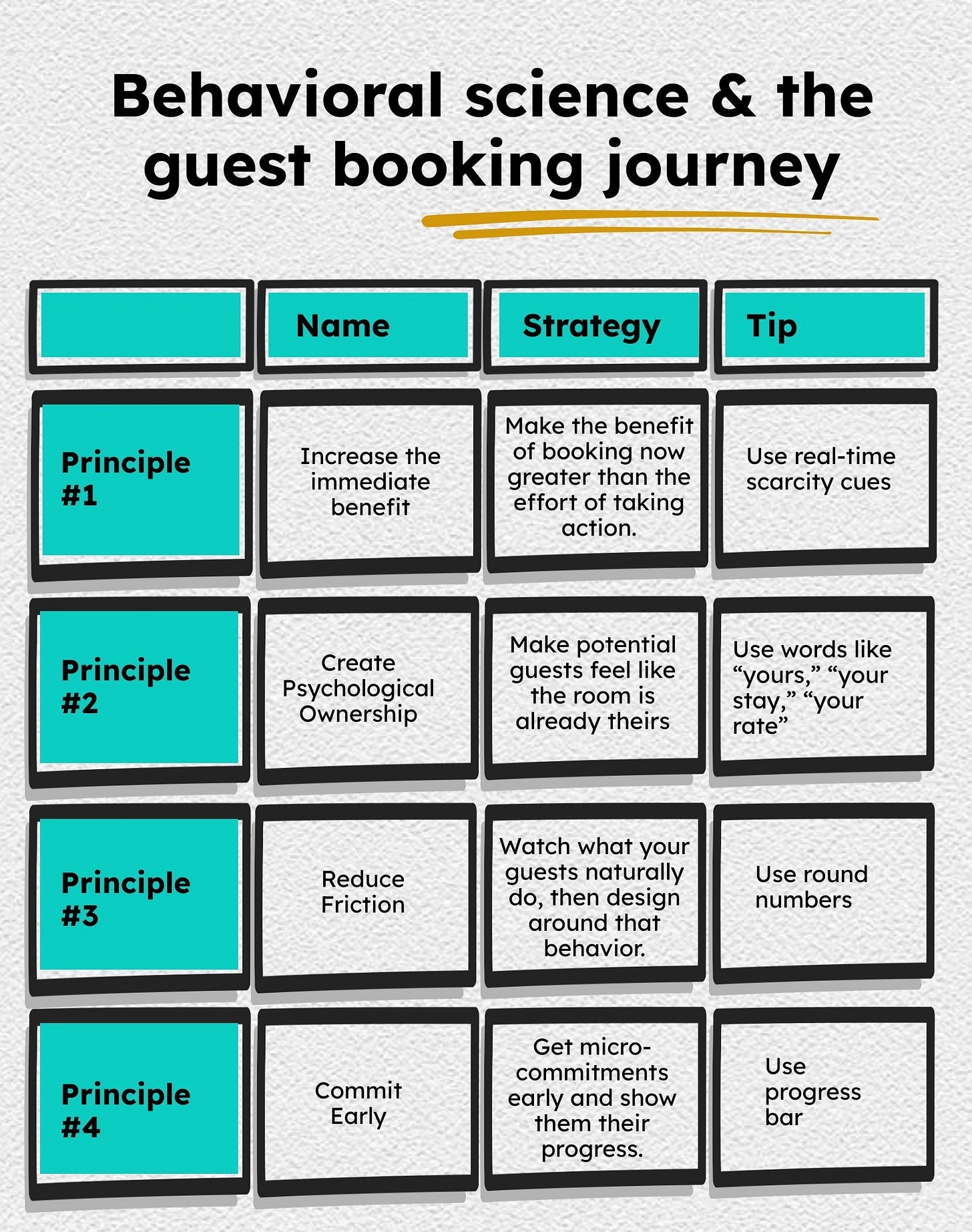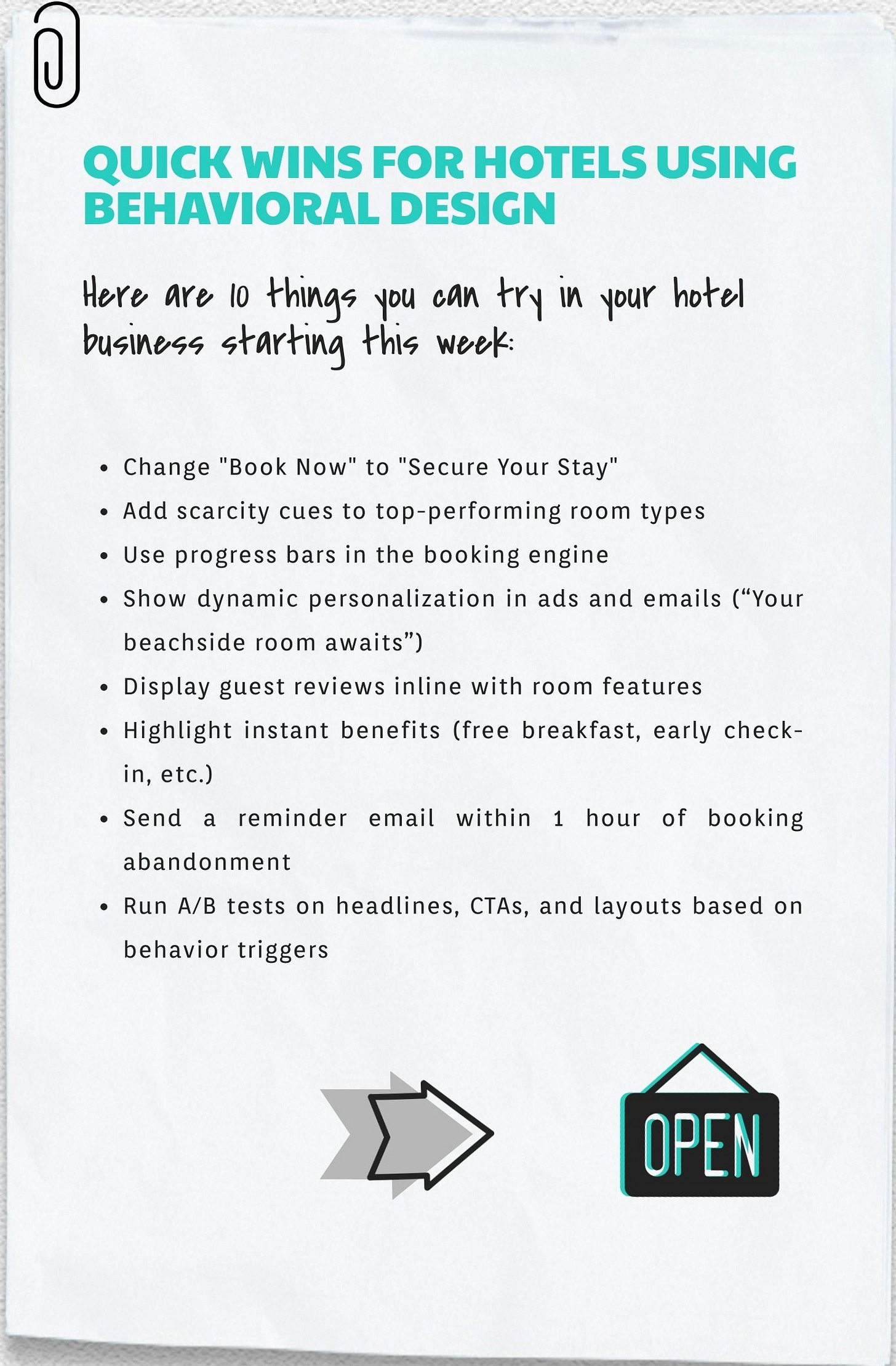How hotels can use psychology to drive direct bookings
Behavioral science and the guest booking journey
Most of us assume guests make decisions based on logic: dates, price, reviews, and room types. But in reality, human behavior is far more irrational — especially online. People say one thing, do another, abandon carts, second-guess themselves, and miss out on things they actually want.
Understanding how guests make decisions — not just what they say they want, but what they actually do — is the key to unlocking more bookings, better experiences, and smarter marketing.
Enter behavioral design — the application of psychology and behavioral economics to product, UX, and marketing. More than ever, hotel brands are using it to redesign their websites, booking engines, emails, and even in-stay experiences.
Here’s how to apply it across the guest journey — with real strategies and hospitality-focused examples.
🔥 Principle #1: Increase the immediate benefit — Fight present bias
"Make now feel better than later — that's how you beat the booking blues."
One of the most powerful cognitive biases at play in guest behavior is present bias.
This is our tendency to overvalue the immediate cost of an action, and undervalue the long-term reward.
In booking terms, this means:
“I don’t feel like filling out a form right now.”
“I’ll compare a few more hotels first.”
“I’m not ready to commit.”
These small drop-off moments kill conversions.
✅ What to do:
Make the benefit of booking now feel greater than the effort of taking action.
A boutique hotel in Barcelona (specific details withheld due to NDA) conducted an A/B test on their booking engine flow. One version featured a standard call-to-action button labeled “Book Now.” The alternative version included a sense of urgency: “Book now — only 2 rooms left at this rate.”
Result? A 19% increase in completed bookings.
Urgency (limited availability) and value (a good deal) beat out neutral language. Why? Because they made the immediate benefit of acting now more powerful than the friction of clicking through.
💡 Tip:
Use real-time scarcity cues (e.g. “3 other guests are viewing this room”).
Highlight what they get right away: free cancellation, breakfast included, pay later.
Show progress (e.g. “You're 2 steps from confirming your stay”).
💼 Principle #2: Create psychological ownership — The endowment effect
"Don't ask guests to decide — make them feel like they've already chosen."
Pedro Calvo
The endowment effect describes how people assign more value to things once they feel ownership over them — even if they don’t actually possess them yet.
✅ What to do:
Make potential guests feel like the room is already theirs — before they’ve booked it.
Instead of saying “Explore our rooms,” a hotel website tested “Find your room” and later “Your perfect room is waiting.”
Bookings increased by 12%.
Why? The second version shifted the decision from exploration to claiming something already theirs.
Other ways to create ownership:
Use words like “yours,” “your stay,” “your rate”
Let users pre-select features (e.g. view, bed type) early in the journey
Show their name in confirmation previews: “Ana, you’re 1 click from your stay at The Grand”
🎯 Principle #3: Reduce friction — Lean into what guests already do
Most hotel booking flows are designed to make sense — but not necessarily to feel easy.
Friction isn't always visible. It could be:
Asking for info too early
Making guests scroll too much
Requiring login before price reveal
Not matching what guests expect from other sites
✅ What to do:
Watch what your guests naturally do — then design around that behavior.
One hotel noticed most guests searched for "best deals" and "packages" rather than individual rooms. So, instead of listing all rooms first, the homepage shifted to showcasing 3 pre-bundled offers (e.g., Romantic Escape, Family Weekend, Business Smart Rate).
The change aligned with how guests naturally categorize their intent — and increased clicks to the booking engine by 33%.
Another classic tactic: use round numbers. When offering discounts, test pricing at $200 instead of $197.63. People naturally process rounded values faster and feel more confident acting on them.
📅 Principle #4: Commit early — Leverage day 1 momentum
Behavioral science tells us: Day one is your golden window for commitment.
When someone lands on your site or clicks your ad, their intent is at its peak — but that moment fades fast. Wait too long, and you lose the momentum.
This taps into the goal gradient effect: people are more likely to take action when they feel like they’re already making progress.
Tinder didn’t reinvent dating — they gamified momentum.
Swiping left or right was effortless, but powerful. Each small decision created forward motion, not fatigue. People weren’t just browsing — they were progressing. And that feeling? Addictive.
✅ What to do:
Get micro-commitments early and show them their progress.
A resort in Costa Rica tested a simple form at the top of their homepage:
“Plan your perfect stay — choose your dates to get started.”
Even before entering the booking engine, users were already interacting with the idea of staying — and were twice as likely to complete a booking later in the session.
Another example: An email campaign that opened with:
“You’re just 2 clicks away from your next escape.”
It outperformed a generic promo by 28%.
🧠 How to start applying behavioral design in your Hotel
Behavioral science isn’t just for psychologists — it’s a practical tool for every hotel marketer, GM, and revenue manager. But you need the right process.
🛠 Step 1: Pick one key behavior
What’s the one behavior you want to change? Be ultra-specific.
✅ Don’t say: “Increase conversions”
✅ Say: “Get first-time visitors to start the booking flow within 10 seconds”
If you're not clear on the specific action, the rest of your efforts will scatter.
🗺 Step 2: Map the guest journey (Behavioral map)
Go beyond the typical guest journey. Build a behavioral map: every tiny cognitive and emotional step a guest takes from search to booking.
Ask:
What do they feel?
What do they believe?
Where do they hesitate?
Where do they bounce?
This is where behavioral barriers hide — and where your biggest wins lie.
🎯 Step 3: Identify biases at play
At every step, ask:
Is this moment triggering friction?
Are we fighting or leveraging bias?
Are we aligning with their natural motivation?
The 3 most common biases in booking:
Present bias (delaying good decisions)
Loss aversion (fearing missing out)
Choice overload (too many options = no action)
🧪 Step 4: Run theory-based experiments
Don’t just redesign blindly. Test specific hypotheses based on real behavioral insights.
Example:
Hypothesis: Showing room scarcity will increase booking completion.
Test: Version A = neutral room listings | Version B = “Only 2 left!” tags
Track: Sessions to booking confirmation
Run experiments one variable at a time so you can isolate what actually drives results.
🚀 Quick wins for Hotels using behavioral design
Next posts:
Managing up: Want to fast-track your career in hotels? Get noticed for promotions? Earn more freedom and trust from leadership? There's one skill you absolutely must master: 👉 Managing up
With expert insights from Pedro Calvo Domínguez, ex HHRR Director at Sony and Ford (Spain & Portugal), we’ll break down how learning to manage up can dramatically shift how you’re seen — and how far you go.
The conversion flywheel behind Genially: How we acquired 30 million users. As Genially’s VP of Marketing for 3 years, I had a front-row seat to what made our growth engine spin. It wasn’t just one hack or campaign — it was a set of repeatable, compounding levers that turned first-time users into advocates and fueled a flywheel that brought in over 30 million users.
💡 Stay ahead of the curve with the latest industry insights! Subscribe to: This Week in Hospitality for a weekly roundup of the most important events shaping the hospitality world.
🌍 For exclusive updates on high-end experiences and luxury travel trends, subscribe to Luxury Travel and never miss a beat in the world of premium hospitality.
🙏 Thanks for reading Hotel Industry Insights!
Join 9,988 hoteliers already transforming their businesses with innovative, practical strategies.
💡 Found this edition valuable? Show some love by hitting the ❤️ and sharing it with colleagues, friends, or on social media!
Want to showcase your company to 10,000+ hospitality decision-makers? Learn more here.






